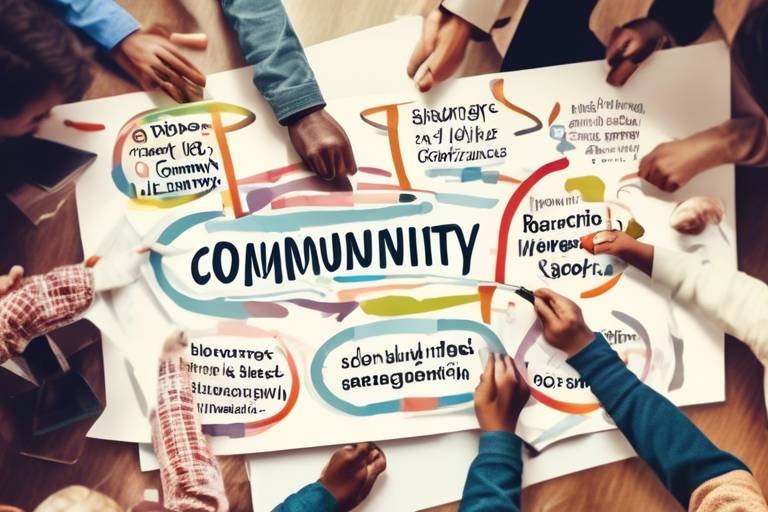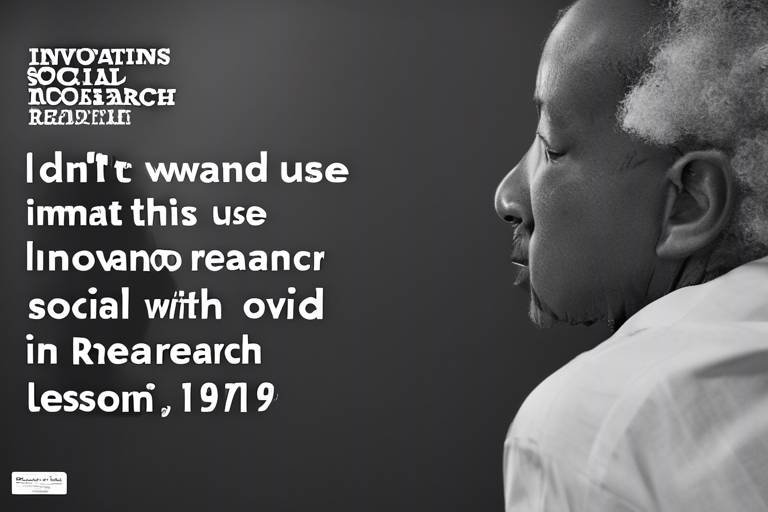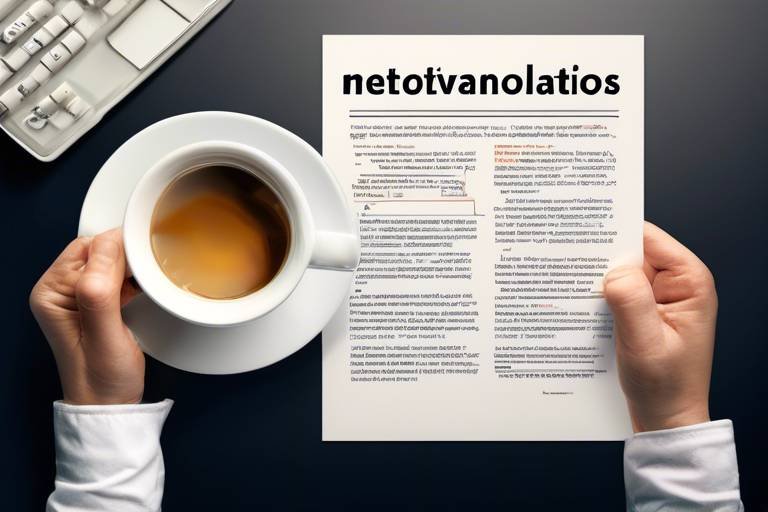How to Integrate Community Engagement in Research Design
In an era where research impacts every facet of our lives, integrating community engagement into research design has become not just beneficial but essential. Imagine a world where the voices of the community resonate through every research finding, where the outcomes are not just numbers on a page but stories of real people. This is the transformative power of community engagement. By fostering collaboration, inclusivity, and ethical considerations, researchers can create impactful studies that not only address community needs but also empower those involved. In this article, we will delve into effective strategies for incorporating community engagement into research design, ensuring that the outcomes are not only relevant but also resonate deeply with the communities they aim to serve.
At its core, community engagement is about collaboration between researchers and community members. It’s not just a checkbox to tick off; it’s a commitment to fostering mutual respect and shared goals. Think of it as a dance where both partners must be in sync to create something beautiful. This section will define key concepts related to community engagement and highlight its significance in research design. When researchers actively involve community members in the research process, they not only gain valuable insights but also build a foundation of trust that can lead to more meaningful results. By recognizing the unique perspectives and experiences of community members, researchers can tailor their methodologies to better address the needs and concerns of those they aim to serve.
Engaging communities in research design offers numerous benefits that can significantly enhance the quality and relevance of research outcomes. Here are some of the key advantages:
- Enhanced Relevance: Research that considers community input is more likely to address real-world issues that matter to the community.
- Increased Trust: Building relationships with community members fosters trust, which is crucial for the success of any research project.
- Improved Data Quality: Community members can provide insights that lead to richer, more nuanced data.
These advantages contribute to successful research outcomes, helping to ensure that the findings are not only statistically significant but also socially relevant. When community members feel valued and heard, they are more likely to engage with the research process, leading to a cycle of trust and collaboration that benefits everyone involved.
Trust is fundamental in community engagement. It’s like the glue that holds the relationship between researchers and community members together. Without it, even the best research designs can fall flat. To establish and maintain trust, researchers should focus on transparency, consistency, and active listening. For example, being clear about research goals and methodologies can alleviate concerns and foster a sense of partnership. Additionally, respecting community norms and values is crucial; it shows that researchers are not just there to extract data but are genuinely invested in the community's well-being.
Clear and open communication is crucial for successful engagement. Researchers should adopt best practices for communicating research intentions and findings to community stakeholders. This can include:
- Using simple, jargon-free language that is accessible to all community members.
- Holding regular meetings to update the community on research progress and findings.
- Creating visual aids, such as infographics, to make complex data more understandable.
By prioritizing effective communication, researchers can ensure that community members feel informed and involved throughout the research process.
Implementing feedback mechanisms is essential to ensure that community voices are heard. This can be achieved through various methods such as surveys, focus groups, and community forums. By actively soliciting feedback, researchers can gain valuable insights that can shape the research design and outcomes. Moreover, integrating community feedback demonstrates respect for their input, fostering a sense of ownership over the research process.
Ethics play a vital role in community engagement. Researchers must consider essential ethical principles when involving communities in their work. This includes obtaining informed consent, ensuring confidentiality, and being transparent about the use of research findings. Ethical engagement not only protects community members but also enhances the credibility of the research. When communities trust that researchers have their best interests at heart, they are more likely to engage meaningfully in the research process.
Different methodologies can be employed to engage communities effectively. Participatory research and co-design are two approaches that stand out for their ability to enhance community involvement. Participatory research empowers community members by involving them in the research process, leading to more relevant and impactful outcomes. Co-design workshops facilitate collaboration between researchers and community members, generating innovative ideas and fostering shared ownership of research projects.
Participatory research approaches are designed to empower community members by involving them directly in the research process. This can lead to more relevant outcomes that reflect the true needs and priorities of the community. By working together, researchers and community members can co-create knowledge that is not only academically valid but also practically applicable.
Co-design workshops are another effective method for engaging communities. These workshops bring together researchers and community members to brainstorm and develop research ideas collaboratively. This not only generates innovative solutions but also fosters a sense of shared ownership over the research project. When community members feel that they have a stake in the research, they are more likely to support and engage with the findings.
Evaluating the effectiveness of community engagement is essential for continuous improvement. Researchers should employ various evaluation techniques and metrics to assess the impact of community involvement in research design. This can include qualitative assessments through interviews and focus groups, as well as quantitative measures such as surveys to gauge community satisfaction and engagement levels. By regularly evaluating their engagement efforts, researchers can adapt and refine their approaches to better meet the needs of the communities they serve.
- What is community engagement in research?
Community engagement in research refers to the collaborative process of involving community members in the research design, implementation, and evaluation to ensure that the research addresses their needs and concerns.
- Why is community engagement important?
Community engagement is important because it enhances the relevance, trust, and quality of research outcomes, leading to findings that are more applicable and beneficial to the community.
- How can researchers build trust with communities?
Researchers can build trust by being transparent, consistent, and respectful of community values, as well as actively listening to community members' concerns and feedback.

Understanding Community Engagement
Community engagement is more than just a buzzword; it's a vital approach that bridges the gap between researchers and the communities they study. At its core, community engagement involves a collaborative partnership where both researchers and community members work together toward shared goals. This partnership is built on the foundation of mutual respect and understanding, allowing for a more inclusive research environment. Imagine trying to solve a puzzle without knowing what the final picture looks like. That’s how research can feel without community input—fragmented and incomplete.
When we talk about community engagement, we’re not just referring to gathering data or conducting surveys. It’s about fostering a relationship that values the perspectives and experiences of community members. This means actively involving them in the research process from the very beginning. By doing so, researchers can better understand the unique challenges and strengths of the community, ensuring that the research is not only relevant but also impactful. Think of it like cooking a meal; you wouldn't just throw ingredients together without tasting and adjusting to the preferences of those you’re serving.
Moreover, the significance of community engagement in research design cannot be overstated. It enhances the relevance of research findings, as community input helps shape the questions being asked and the methods being used. This leads to data that truly reflects the needs and realities of the community. Engaging the community also builds trust, which is essential for gathering honest and accurate information. When community members feel valued and heard, they are more likely to participate actively, leading to improved data quality and richer insights.
In addition, community engagement promotes a sense of ownership among community members. When they are involved in the research process, they are more likely to support and advocate for the findings. This is crucial for the implementation of research outcomes, as community buy-in can significantly influence the success of initiatives aimed at addressing the issues identified through research.
To summarize, community engagement is a dynamic process that involves:
- Collaboration: Working together with community members throughout the research cycle.
- Inclusivity: Ensuring diverse voices and perspectives are represented.
- Trust-building: Establishing strong relationships that facilitate open communication.
- Ownership: Empowering communities to take charge of the research outcomes.
By understanding and implementing these principles, researchers can create a more inclusive and effective research design that not only meets academic standards but also serves the community's needs. In the end, community engagement is about creating a synergistic relationship where both parties learn from each other, leading to outcomes that are beneficial for all involved.

Benefits of Community Engagement
Engaging communities in research design is not just a trendy buzzword; it’s a powerful approach that can transform the way research is conducted and perceived. When researchers actively involve community members, the benefits are manifold, creating a win-win situation for all parties involved. First and foremost, community engagement enhances the relevance of research. By incorporating local knowledge and perspectives, researchers can ensure that their studies address real-world issues that matter to the community. This relevance not only boosts the legitimacy of the research but also increases the likelihood that the findings will be utilized effectively.
Moreover, community engagement fosters trust between researchers and community members. Trust is the bedrock of any collaborative effort, and when researchers demonstrate a genuine commitment to understanding and valuing community input, it paves the way for deeper relationships. This trust can lead to communities being more open and willing to share their insights, which ultimately enriches the data quality. When community members feel heard and respected, they are more likely to provide honest feedback and share their experiences, leading to a more comprehensive understanding of the research topic.
Another significant advantage of community engagement is the potential for improved data quality. Engaging community members not only helps in gathering diverse perspectives but also aids in identifying potential biases that researchers might overlook. For instance, community members might bring up local issues or cultural nuances that researchers would not have considered. This collaboration ensures that the data collected is not only robust but also reflective of the community's true needs and concerns.
Additionally, community engagement can lead to more sustainable outcomes. When communities are involved in the research process, they are more likely to take ownership of the findings and implement changes based on them. This sense of ownership encourages ongoing dialogue and collaboration, ensuring that the benefits of the research extend beyond the initial study. In essence, the community becomes a partner in the research journey, rather than just a subject of study.
To illustrate these benefits more clearly, consider the following table highlighting key advantages of community engagement:
| Benefit | Description |
|---|---|
| Enhanced Relevance | Research addresses real-world issues that matter to the community. |
| Increased Trust | Stronger relationships between researchers and community members. |
| Improved Data Quality | Diverse perspectives lead to more comprehensive insights. |
| Sustainable Outcomes | Communities take ownership and implement changes based on findings. |
In summary, the benefits of community engagement in research design are profound. By fostering relevance, trust, data quality, and sustainability, researchers not only enhance their studies but also contribute positively to the communities they work with. It’s a collaborative approach that redefines the research landscape, making it more inclusive and impactful.
- What is community engagement in research? Community engagement in research refers to the collaboration between researchers and community members to ensure that the research addresses the needs and concerns of the community.
- Why is trust important in community engagement? Trust is essential for open communication and collaboration, leading to better data quality and more meaningful research outcomes.
- How can researchers effectively engage communities? Researchers can engage communities through participatory approaches, co-design workshops, and by maintaining clear and open communication throughout the research process.

Building Trust with Communities
Trust is the cornerstone of effective community engagement. Without it, even the most well-planned research initiatives can falter. Imagine trying to build a house without a solid foundation; it simply won’t stand the test of time. Similarly, researchers must lay a robust groundwork of trust to ensure that their projects resonate with community members. So, how can researchers cultivate this essential trust? It begins with transparency and consistency.
First and foremost, researchers should be transparent about their intentions. This means clearly communicating the purpose of the research, how it will benefit the community, and what the community's role will be in the process. When community members understand what to expect, they are more likely to engage positively. For instance, hosting initial meetings to discuss the research goals and inviting questions can demystify the process and foster an environment of openness.
Moreover, consistency in interactions builds reliability. Researchers should strive to maintain regular communication with community members throughout the research process. This could be through updates via newsletters, community meetings, or even social media platforms. By keeping the lines of communication open, researchers not only keep the community informed but also demonstrate their commitment to the project. It’s like watering a plant; consistent care leads to growth and flourishing relationships.
Another vital aspect of building trust is active listening. Researchers must genuinely listen to community concerns and feedback. This involves creating spaces where community members feel safe to voice their opinions. Implementing feedback mechanisms, such as surveys or focus groups, can provide valuable insights and show that researchers value the community's input. When community members see their feedback being taken seriously, trust deepens.
Furthermore, engaging community leaders can significantly enhance trust-building efforts. Leaders often serve as trusted figures within their communities and can act as bridges between researchers and community members. By collaborating with these leaders, researchers can gain credibility and access to a wider audience. This partnership can transform the research process into a collective journey, where both parties work towards a shared goal.
In essence, building trust with communities requires a multifaceted approach. Researchers must be transparent, consistent, and actively listen to community voices. By engaging local leaders and fostering open communication, researchers can create a strong foundation for successful community engagement. After all, trust is not built overnight; it takes time, effort, and a genuine commitment to collaboration.
- What is the importance of trust in community engagement?
Trust is crucial because it fosters open communication, encourages participation, and enhances the overall quality of the research outcomes. - How can researchers ensure transparency?
Researchers can ensure transparency by clearly communicating their research intentions, goals, and how the community will benefit from the project. - What role do community leaders play in building trust?
Community leaders can help bridge the gap between researchers and the community, lending credibility and facilitating broader engagement. - How can feedback mechanisms be effectively implemented?
Feedback mechanisms can be implemented through surveys, focus groups, or community meetings, ensuring that community voices are heard and valued.

Effective Communication Strategies
When it comes to community engagement, effective communication is like the lifeblood of a successful research project. Imagine trying to build a bridge without a clear blueprint; that’s what engaging communities without proper communication can feel like. To foster collaboration and inclusivity, researchers must prioritize open dialogues with community members. This involves not just sharing information but actively listening to the community's voices, concerns, and aspirations. By establishing a two-way communication channel, researchers can ensure that community members feel valued and respected, which is essential for building a solid foundation of trust.
One of the most effective strategies is to use clear and accessible language. Avoiding jargon and technical terms can make a world of difference. Think about it: would you rather read a dense research paper or a friendly conversation over coffee? By simplifying language, researchers can make their findings more relatable and understandable, allowing community members to engage more deeply with the research process. Additionally, utilizing various formats, such as infographics, videos, and community meetings, can cater to different preferences and enhance comprehension.
Furthermore, regular updates about the research progress can keep the community engaged and informed. Consider setting up a communication schedule that outlines when and how updates will be shared. This could include:
- Monthly newsletters highlighting key findings and future steps.
- Community forums where researchers present their progress and invite feedback.
- Social media updates that keep the conversation alive and accessible.
Another critical aspect is to actively solicit feedback from the community. Feedback mechanisms, such as surveys or focus groups, provide a platform for community members to share their thoughts and experiences related to the research. This not only empowers them but also enriches the research process itself. By integrating community feedback into the research design, researchers can ensure that their work resonates with the community's needs and values, ultimately leading to more impactful outcomes.
In conclusion, effective communication strategies are essential for fostering genuine community engagement in research. By prioritizing clarity, accessibility, and responsiveness, researchers can build stronger relationships with community members, paving the way for collaborative and meaningful research experiences. Remember, communication is not just about talking; it's about creating a space where everyone feels heard and valued.
Q: Why is effective communication important in community engagement?
A: Effective communication builds trust, ensures clarity, and encourages active participation from community members, making the research process more inclusive and impactful.
Q: What are some ways to communicate research findings to the community?
A: Researchers can use newsletters, community meetings, social media updates, and visual aids like infographics to share findings in an accessible manner.
Q: How can feedback from the community improve research outcomes?
A: Community feedback helps researchers understand the needs and perspectives of the community, allowing for adjustments that enhance the relevance and effectiveness of the research.

Feedback Mechanisms
Integrating effective into community engagement is like adding a secret ingredient to a recipe—it can transform the final dish into something truly remarkable. Feedback mechanisms serve as the bridge between researchers and community members, ensuring that the voices of those directly impacted by research are not only heard but valued. By establishing robust systems for gathering feedback, researchers can foster a sense of ownership and collaboration, which is essential for the success of any research project.
One of the most effective ways to collect feedback is through surveys. Surveys can be designed to gather quantitative and qualitative data from community members, allowing researchers to understand their perspectives, needs, and concerns. However, it's crucial that these surveys are crafted with care. Questions should be clear, concise, and relevant to the community’s context. Additionally, providing respondents with the option to remain anonymous can encourage more honest and open feedback.
Another powerful feedback mechanism is through focus groups. These small, interactive discussions allow community members to express their thoughts in a more personal setting. Focus groups can unveil insights that surveys might miss, as participants often build on each other's ideas. However, it’s essential to facilitate these sessions skillfully, ensuring that all voices are heard and respected. Researchers should aim to create an environment where community members feel comfortable sharing their thoughts without fear of judgment.
Incorporating community forums is another effective strategy. These gatherings can be organized to discuss research findings, gather input, and brainstorm solutions collaboratively. Forums not only provide a platform for feedback but also strengthen the relationship between researchers and community members. They can be held in various formats—physical meetings, online webinars, or even social media discussions—depending on what works best for the community.
Moreover, using digital platforms for feedback collection can significantly enhance engagement. Online tools such as social media, dedicated community apps, or feedback websites allow for continuous dialogue. These platforms can be particularly effective in reaching younger demographics who are more comfortable with technology. However, researchers should ensure that these digital tools are accessible to all community members, considering factors like internet access and digital literacy.
Lastly, it’s essential to close the feedback loop. This means not only collecting feedback but also acting on it and communicating back to the community about how their input has influenced the research. This transparency builds trust and encourages ongoing participation. Researchers can share updates through newsletters, community meetings, or social media posts, highlighting how community feedback has shaped the research direction.
In summary, establishing effective feedback mechanisms is vital for fostering genuine community engagement. By employing a mix of surveys, focus groups, community forums, and digital tools, researchers can ensure that they are not only hearing but truly listening to the communities they aim to serve. Remember, the goal is not just to collect feedback but to create a dynamic and ongoing conversation that enriches the research process and outcomes.
- What are feedback mechanisms? Feedback mechanisms are tools and processes used to gather opinions, suggestions, and insights from community members regarding research activities.
- Why are feedback mechanisms important in research? They ensure that the voices of community members are heard, fostering collaboration and improving the relevance and impact of the research.
- How can I ensure my feedback mechanisms are effective? Ensure clarity in your questions, create a safe space for discussions, and be transparent about how feedback will influence the research.
- What types of feedback mechanisms can be used? Surveys, focus groups, community forums, and digital platforms are all effective methods for gathering feedback.

Ethical Considerations in Community Engagement
When it comes to community engagement, ethical considerations are not just an afterthought; they are the backbone of the research process. Engaging with communities means stepping into a world of diverse perspectives, histories, and values. Therefore, researchers must approach this engagement with a profound sense of responsibility and respect. One of the primary ethical principles is informed consent. This means that community members should be fully aware of the research's purpose, methods, and potential impacts before agreeing to participate. It’s essential to ensure that consent is not merely a formality but a genuine understanding of what involvement entails.
Moreover, reciprocity is another vital ethical consideration. Researchers should aim to give back to the community in meaningful ways, whether through sharing findings, providing resources, or contributing to community development. This two-way street fosters a sense of partnership rather than a one-sided transaction. Researchers must also be vigilant about power dynamics. Often, researchers hold more power due to their knowledge and resources. Acknowledging this imbalance and actively working to mitigate it is crucial for genuine engagement.
Transparency in communication is equally important. Researchers should maintain open lines of communication with community members throughout the research process. This includes sharing updates, findings, and any changes in the research plan. Not only does this build trust, but it also empowers community members by keeping them in the loop. Furthermore, researchers should consider the potential impact of their work on the community. It’s imperative to evaluate how the research might affect the community both positively and negatively, ensuring that the benefits outweigh any potential harm.
In addition to these principles, researchers should also prioritize the confidentiality of community members. Protecting the identities and personal information of participants is not just a legal obligation; it’s an ethical one. This means implementing measures to anonymize data and ensuring that any publications do not inadvertently reveal sensitive information.
In summary, ethical considerations in community engagement are multifaceted and demand a thoughtful approach. By prioritizing informed consent, reciprocity, transparency, and confidentiality, researchers can create a foundation of trust and respect that enhances the quality and impact of their work. Engaging ethically with communities not only enriches the research process but also contributes to more meaningful and sustainable outcomes.
- What is the importance of ethical considerations in community engagement?
Ethical considerations ensure that community members are respected, informed, and engaged in a meaningful way, leading to more impactful research outcomes. - How can researchers ensure informed consent?
Researchers can ensure informed consent by clearly explaining the research purpose, methods, and potential impacts, allowing community members to ask questions before agreeing to participate. - What does reciprocity mean in the context of community engagement?
Reciprocity refers to the mutual benefit in the researcher-community relationship, where researchers give back to the community in ways that are meaningful and supportive.

Methods for Engaging Communities
Engaging communities in research is not just about collecting data; it's about creating a partnership that fosters mutual growth and understanding. To truly integrate community voices into research, researchers must employ a variety of methodologies that resonate with the community's needs and aspirations. This section dives into some of the most effective methods for community engagement, including participatory research and co-design workshops, both of which are pivotal in ensuring that research is not only relevant but also impactful.
Participatory research is a dynamic approach that actively involves community members in the research process. Instead of researchers simply collecting data from communities, this method encourages community members to take an active role in shaping the research questions, data collection methods, and even the analysis of results. This collaborative approach not only enhances the relevance of the research but also empowers community members, giving them a sense of ownership over the findings. Imagine a community coming together to solve their own issues, with researchers acting as facilitators rather than authorities. This shift in perspective can lead to more meaningful outcomes.
Co-design workshops are another innovative method for engaging communities. These workshops bring researchers and community members together in a creative space where ideas can flow freely. Participants brainstorm and collaborate on solutions to specific issues, allowing for a rich exchange of perspectives. The beauty of co-design workshops lies in their ability to foster innovation and creativity. By engaging community members in the design process, researchers can tap into local knowledge and insights that might otherwise go unnoticed. It's like throwing a potluck dinner—everyone brings something unique to the table, and together, they create a feast of ideas.
To illustrate the effectiveness of these methods, consider the following table that outlines the key characteristics and benefits of participatory research and co-design workshops:
| Method | Characteristics | Benefits |
|---|---|---|
| Participatory Research | Involves community members in all stages of research | Enhances relevance, builds trust, and empowers communities |
| Co-Design Workshops | Collaborative sessions for brainstorming and idea generation | Fosters innovation, encourages shared ownership, and utilizes local knowledge |
Ultimately, the methods chosen for community engagement should be tailored to the specific context and needs of the community. It's essential to approach each engagement with an open mind and a willingness to adapt. Researchers should also be prepared to face challenges, such as differing opinions or resistance to change. But remember, these hurdles can often lead to the most rewarding outcomes when approached with patience and understanding.
In conclusion, employing methods like participatory research and co-design workshops can significantly enhance community engagement in research. By actively involving community members, researchers not only gain invaluable insights but also foster a collaborative environment that can lead to more effective and sustainable solutions. The key takeaway? When communities are engaged, research becomes a powerful tool for change.
- What is community engagement in research? Community engagement in research refers to the collaboration between researchers and community members to ensure that research is relevant, ethical, and beneficial to the community.
- Why is participatory research important? Participatory research empowers community members, increases the relevance of findings, and fosters trust between researchers and the community.
- How can co-design workshops benefit research? Co-design workshops facilitate collaboration and creativity, allowing for innovative solutions that are informed by local knowledge and perspectives.
- What challenges might arise during community engagement? Challenges can include differing opinions, resistance to change, and logistical issues, but these can often lead to productive discussions and better outcomes.

Participatory Research Approaches
Participatory research approaches are not just a trend; they represent a fundamental shift in how we think about research. Imagine a world where community members are not just subjects of research but active participants in the entire process. This is the essence of participatory research. It empowers individuals by involving them in every phase of the research cycle, from defining the problem to analyzing the data and disseminating the findings. By placing community members at the heart of research, we can ensure that the outcomes are not only relevant but also impactful.
One of the most powerful aspects of participatory research is its ability to bridge the gap between academia and the community. Researchers often come with their own perspectives and biases, which can unintentionally skew the research. However, when community members are involved, they bring their lived experiences, insights, and knowledge, enriching the research process. This collaborative approach fosters a sense of ownership among community members, making them more likely to engage with the findings and use them to advocate for change.
Consider a community facing high rates of obesity. A traditional research approach might involve researchers collecting data from the community, analyzing it in isolation, and then presenting findings that may not resonate with the community's actual experiences. In contrast, a participatory approach would involve community members in identifying the root causes of obesity, brainstorming solutions, and even implementing interventions. This not only leads to more relevant findings but also empowers the community to take action.
There are several key principles that guide participatory research approaches:
- Collaboration: Researchers and community members work together as equal partners.
- Empowerment: Community members gain skills and knowledge through their involvement.
- Action-oriented: The focus is on generating actionable insights that lead to positive change.
- Reflection: Continuous reflection on the process and outcomes helps improve future research endeavors.
To illustrate the effectiveness of participatory research approaches, let's take a look at a case study involving a local health initiative. In this project, researchers collaborated with residents to address health disparities in their neighborhood. Through workshops and focus groups, community members identified barriers to accessing healthcare and proposed solutions, such as mobile clinics and community health fairs. The researchers facilitated the process, ensuring that the voices of the community were prioritized. As a result, the initiative not only improved healthcare access but also strengthened community bonds. This is the power of participatory research—it's about creating solutions together.
In summary, participatory research approaches are a game-changer in the realm of research design. By integrating the voices and insights of community members, researchers can create studies that are not only more relevant but also more effective. This collaborative spirit not only enriches the research but also fosters a sense of community ownership and empowerment, paving the way for sustainable change.

Co-Design Workshops
Co-design workshops are a dynamic approach that brings together researchers and community members to collaboratively shape research projects. Imagine a vibrant space where ideas flow freely, and every voice is valued. This method not only fosters creativity but also ensures that the research reflects the community's needs and aspirations. By engaging participants in the design process, researchers can tap into the rich insights and experiences that community members bring to the table.
These workshops typically involve a series of structured activities designed to facilitate brainstorming and discussion. Participants might engage in activities such as mapping out community challenges, identifying potential solutions, or even prototyping ideas. The atmosphere is often electric, as diverse perspectives merge to create innovative solutions that might not have emerged in a traditional research setting. The key here is to create a safe and inclusive environment where everyone feels comfortable sharing their thoughts.
One of the remarkable aspects of co-design workshops is their flexibility. They can be tailored to suit the specific context and goals of the research project. For instance, a workshop aimed at developing health interventions might include role-playing scenarios to explore patient experiences, while a workshop focused on urban planning might involve interactive mapping exercises. This adaptability makes co-design workshops a powerful tool for researchers seeking to engage communities meaningfully.
Moreover, co-design workshops can lead to a sense of ownership among participants. When community members are actively involved in shaping the research, they are more likely to support and advocate for the outcomes. This sense of ownership can be particularly valuable in ensuring the sustainability of research initiatives. After all, when people feel invested in a project, they are more likely to champion its findings and help implement solutions.
To illustrate the effectiveness of co-design workshops, consider the following table that outlines key benefits:
| Benefit | Description |
|---|---|
| Enhanced Relevance | Research outcomes are more aligned with community needs and priorities. |
| Increased Innovation | Collaboration fosters creative solutions that might not arise in isolation. |
| Strengthened Relationships | Building trust and rapport between researchers and communities enhances future collaborations. |
| Empowerment | Community members gain skills and confidence to participate in research and decision-making processes. |
In conclusion, co-design workshops are not just a trend; they represent a fundamental shift in how research is conducted. By prioritizing collaboration and inclusivity, these workshops can lead to outcomes that are not only scientifically sound but also deeply rooted in the realities of the communities they aim to serve. As researchers continue to embrace this approach, the potential for impactful, community-driven research will only grow.
Q1: What is the main goal of co-design workshops?
A1: The primary goal is to involve community members in the research design process, ensuring that the outcomes are relevant and reflective of their needs.
Q2: How long do co-design workshops typically last?
A2: The duration can vary, but most workshops last between a few hours to a full day, depending on the complexity of the project and the number of activities planned.
Q3: Who should facilitate these workshops?
A3: Ideally, a facilitator experienced in community engagement and participatory methods should lead the workshops to ensure effective communication and inclusivity.
Q4: Can co-design workshops be conducted online?
A4: Yes, with the right tools and platforms, online co-design workshops can be just as effective as in-person sessions, allowing for broader participation.

Evaluating Community Engagement Efforts
Evaluating community engagement efforts is not just a box to check; it’s a crucial component that can shape the future of research projects. Think of it as a compass guiding researchers toward continuous improvement and deeper community connections. Without evaluation, how do we know if our efforts are making a difference? The process of evaluation allows us to assess the effectiveness of our engagement strategies, ensuring that we’re not only meeting our research goals but also fostering genuine relationships with the communities we aim to serve.
To effectively evaluate community engagement, researchers can employ a variety of techniques and metrics. These might include qualitative methods such as interviews and focus groups, which provide rich, detailed insights into community perspectives. Additionally, quantitative measures, such as surveys or participation rates, can help gauge the reach and impact of engagement activities. Combining both approaches often yields the most comprehensive understanding of engagement efforts. For instance, a researcher might conduct a survey to quantify community participation while simultaneously holding focus groups to explore participants' feelings and experiences.
Furthermore, establishing clear objectives at the outset of a project is vital. What do we want to achieve through community engagement? By defining specific, measurable goals, researchers can create a framework for evaluation. For example, if the aim is to increase community awareness about a health issue, metrics might include the number of informational sessions held, attendance rates, and feedback from participants regarding their increased understanding of the topic.
Another critical aspect of evaluation is the establishment of feedback mechanisms. These mechanisms ensure that community voices are not only heard but also integrated into the research process. This could involve creating a feedback loop where community members can share their thoughts on the research design and its implementation. By actively seeking and valuing community input, researchers can adapt their strategies to better meet the needs and expectations of the community. The following table summarizes some effective evaluation techniques:
| Evaluation Technique | Description | Benefits |
|---|---|---|
| Surveys | Structured questionnaires to gather quantitative data. | Easy to analyze and can reach a large audience. |
| Focus Groups | Group discussions that provide qualitative insights. | In-depth understanding of community sentiments. |
| Interviews | One-on-one conversations to explore personal experiences. | Rich, detailed narratives that highlight individual perspectives. |
| Participation Metrics | Tracking attendance and engagement levels at events. | Quantifiable data on community involvement. |
In conclusion, evaluating community engagement efforts is essential for ensuring that research is not only relevant but also beneficial to the communities involved. It helps in identifying what works, what doesn’t, and how we can adapt our strategies for better outcomes. By being transparent about our evaluation processes and sharing results with the community, we build trust and demonstrate our commitment to collaborative research.
- Why is it important to evaluate community engagement? Evaluating community engagement helps determine the effectiveness of strategies used and ensures that the research meets the needs of the community.
- What methods can be used for evaluation? Common methods include surveys, focus groups, interviews, and tracking participation metrics.
- How can community feedback be integrated into research? Community feedback can be collected through various mechanisms, such as surveys or feedback sessions, and should be analyzed and applied to improve research design.
- What are some challenges in evaluating community engagement? Challenges may include obtaining honest feedback, ensuring representative participation, and adapting research strategies based on community input.
Frequently Asked Questions
- What is community engagement in research design?
Community engagement in research design refers to the collaborative process where researchers actively involve community members in the planning, implementation, and evaluation of research projects. This approach fosters mutual respect, shared goals, and ultimately leads to more relevant and impactful research outcomes.
- Why is community engagement important?
Engaging communities in research is crucial because it enhances the relevance of the research, builds trust between researchers and participants, and improves the quality of data collected. When communities feel valued and included, they are more likely to contribute meaningfully, leading to outcomes that better reflect their needs and perspectives.
- How can researchers build trust with communities?
Building trust with communities involves consistent, open communication, transparency about research intentions, and demonstrating genuine respect for community knowledge and input. Researchers should also be present in the community, listen actively, and follow through on commitments to show that they value the partnership.
- What are effective communication strategies for community engagement?
Effective communication strategies include using clear, jargon-free language, actively listening to community concerns, and providing regular updates on the research process. Utilizing multiple channels, such as community meetings, newsletters, and social media, can also help ensure that information reaches a diverse audience.
- What feedback mechanisms can be implemented in community engagement?
Feedback mechanisms can include surveys, focus groups, and community forums that allow participants to voice their opinions and suggestions. Researchers should ensure that these mechanisms are accessible and encourage honest dialogue, integrating community feedback into the research design to enhance its relevance and effectiveness.
- What ethical considerations should researchers keep in mind?
Researchers must prioritize ethical principles such as informed consent, respect for community autonomy, and cultural sensitivity. It’s essential to ensure that community members understand their rights and the purpose of the research, and that their contributions are acknowledged and valued throughout the process.
- What methods can be used to engage communities?
Methods for engaging communities include participatory research approaches, where community members are actively involved in the research process, and co-design workshops that facilitate collaboration in developing research questions and solutions. These methods empower communities and lead to more relevant outcomes.
- How can participatory research approaches benefit communities?
Participatory research approaches benefit communities by giving them a voice in the research process, ensuring that their needs and concerns are addressed. This empowerment can lead to more relevant research outcomes and foster a sense of ownership and pride in the findings.
- What are co-design workshops, and how do they work?
Co-design workshops are collaborative sessions where researchers and community members work together to brainstorm ideas, develop research questions, and design solutions. These workshops promote shared ownership and creativity, often resulting in innovative approaches that reflect the community’s unique context.
- How can researchers evaluate their community engagement efforts?
Researchers can evaluate community engagement efforts by using various techniques, such as surveys to gather participant feedback, analyzing participation rates, and assessing the impact of community involvement on research outcomes. Continuous evaluation helps improve future engagement strategies and ensures that community needs are met.


















